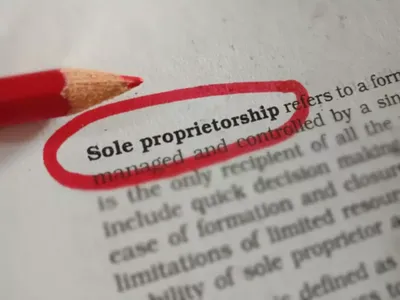Starting a business can be both an intimidating and exciting process. On the one hand, it’s fun to make a dream come true. But on the other, you have to register a business, pay taxes, manage finances, etc.
Choosing a business structure can be challenging since this decision affects the future. Should a business owner go for a limited liability company (LLC), a partnership, a sole proprietorship, or choose other structures? Some business owners found it easier to establish sole proprietorship companies as it’s a relatively easy process. But is it beneficial in the long run?
Kinkos, eBay, JC Penney, and Sears are examples of companies with significant revenue. But did you know that they were established as sole proprietorship companies? These several examples prove that it’s possible to succeed even when starting small. But there must be some pitfalls when it comes to a sole proprietorship.
This article explains a sole proprietorship structure and its advantages and disadvantages. It also shows real-life examples of this business structure.
Understanding Sole Proprietorship
So, what exactly is a sole proprietorship? It’s a form of a business structure owned by one person. The sole proprietorship is also often called sole trader or a proprietorship.
Such a structure leaves this person open to liability. The owner is responsible for all the debts and issues acquired by the business. In simple words, the state treats the company and its owner as a single entity under this business structure.
According to this structure, the owner pays personal income tax on revenue gained from owning the company. One of the reasons why people prefer to establish a business under this structure is the simplicity of a registration procedure.
A proprietorship structure lacks regulations by the government, making it easier to start a business for individual contractors, freelancers, consultants, bookkeepers, and other specialists. In most of these mentioned cases, owners don’t need separate brands since they work under their names.
Moreover, it’s easy to close a proprietorship or switch to a different business structure. For example, if the company keeps growing, it’s possible to reregister as LLC. As for taxes, proprietorship owners are to fill in such forms as Schedule C and Form 1040 when it’s due.
Examples of Sole Proprietorship
As mentioned, it can be hard to choose a business structure when registering a company. In what cases it’s reasonable to open a sole proprietorship? Here are some examples of businesses that run under this structure.
Bookkeeping
It’s a type of service that takes care of the financial needs of other businesses. For example, the bookkeeper records the company’s expenses, profit, and other financial details. As a result, the management clearly understands a business’s financial situation.
Small businesses and organizations often delegate bookkeeping responsibilities to contractors. Meaning, it’s convenient for bookkeepers to register under the sole proprietorship structure.
Computer Repair Services
Most small businesses that offer repair services register as sole proprietorships. Upon starting a business, business owners can either work from home or in small shops.
Catering
Even though catering requires hiring employees for specific events, it’s still possible to register under the proprietorship structure. It offers services to cater business events, parties, celebration events (weddings, birthdays), etc.
House Cleaning
Starting a house cleaning company under a proprietorship structure is more affordable. Additionally, house cleaning company owners can offer laundry, cleaning windows, carpets, etc.
Freelance
Individuals working as photographers, writers, web designers, etc., can register under a sole proprietorship structure. Other businesses can contact freelancers to delegate certain responsibilities.
Home Healthcare
Seniors, people with disabilities often need the aid of professional healthcare workers. It’s possible to register as a proprietorship when providing healthcare services, for example, cooking food, cleaning the house, helping with hygiene needs, etc.
Sole Proprietorship vs. Other Business Structures: Differences
The proprietorship has several differences from other structures. The structure has the following characteristics:
- It gives full control over the business to one person. The owner can operate the business as they wish. For example, they hire and fire employees, invest funds in company optimization, etc. But it also means that the owner is responsible for employees’ wrongdoings.
- It handles control over all assets to the owner. Certain tools and equipment that the company uses to deliver services are a business owner’s property.
- Liability due to lack of regulations from the government.
- Different tax regulations. The owner should report personal profits and losses according to the law.
- The owner can terminate the business any time they want.
To conclude, unlike other business structures, the sole proprietorship is less regulated by the government. This peculiarity leads to advantages and disadvantages of registering a company under this structure.
Benefits and Drawbacks of Sole Proprietorship
Starting a business under a sole proprietorship structure might be a good idea, for instance, in those cases that were mentioned in the article. But before creating a company, it’s wise to learn about the advantages and disadvantages of a chosen structure. That way, a business owner is well-informed about possible risks.
Let’s start with advantages:
- Easy to create a company. Compared to other business structures, it’s easier to register as a proprietorship.
- Flexibility and freedom. An owner has the green light to make any decisions.
- Less paperwork. This structure has different requirements to keep the documentation. Even when creating a company, the state doesn’t require a lot of paperwork.
- Easier to file taxes. It’s also possible to reduce the tax burden.
- Lower business fees. When creating a company under your name, paying registration fees is not necessary.
- Using a personal bank account as a business account. It is recommended to use a separate bank account since it’s easier to calculate taxes.
And disadvantages:
- Difficult to obtain investments and bank credit. Registered businesses may get help from the government, while the proprietorship isn’t eligible for getting governmental funding.
- No liability protection. If a business is in debt, the government won’t protect the owner from losing assets. For example, the owner can lose a house to cover debts.
- Hard to track expenses. Recording business and personal expenses separately is a challenge for many proprietorship owners.
In some cases, it’s more beneficial to start out as a sole proprietorship. For example, when working as an accountant or a web designer. If the business keeps growing and requires more paperwork, it’s possible to switch to a more suitable structure. The key fact to remember is that you can still restructure a company if needed.


















